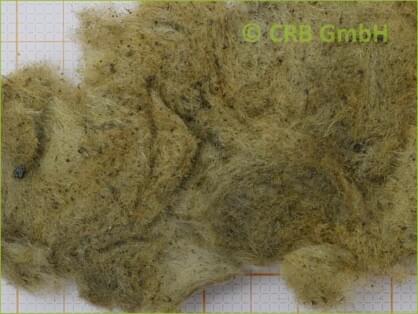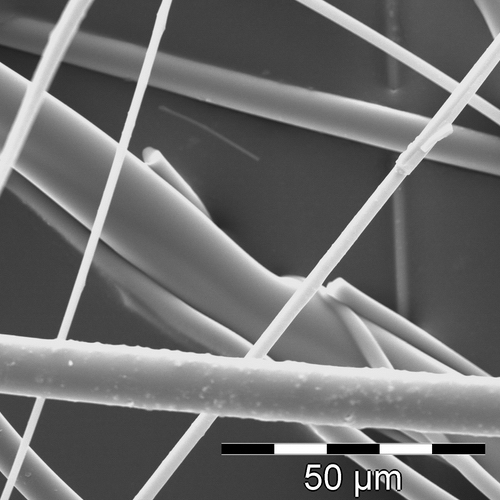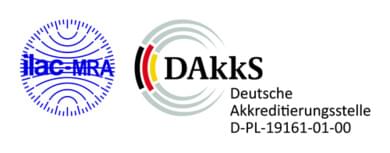Analysis of artificial mineral fibres (AMF): Testing mineral wool for WHO fibres

Our services
We offer the classification of so-called old mineral wools or of those mineral fibres without RAL Quality Mark regarding its carcinogenic potential by
- Testing of man-made mineral fibres for the presence of WHO-fibres by means of Scanning electron microscopy, SEM
- The determination of the 'Carcinogenicity Index, CI' according to IFA / BIA-procedure 7488
WHO-fibres
According to TRGS 905 inorganic fibres with a size of: length of > 5 µm, diameter < 3 µm, length/diameter ratio > 3 : 1, asbestos excepted.
Analysis by means of scanning electron microscope, SEM, as a material sample according to VDI guideline 3866, page 5 for € 62net (€ 73.78 VAT incl.)
|
|||
 |
||
Carcinogenicity index CIThe Carcinogenicity index, CI, is a nondimensional value and calculated from the chemical composition of the mineral fibres to be tested.
According to the IFA / BIA procedure 7488, the CI results from the mass contents in % of Na2O, K2O, CaO, MgO, BaO and B2O3 less twice the mass content of Al2O3. Vitreous mineral fibres are classified according to their CI as defined in technical rule TRGS 905 as follows if their size complies with that of the WHO fibre definition: length > 5µm, diameter < 3 µm, length/diameter ratio > 3 : 1.
Costs for the determination of the Carcinogenicity index CI
Analysis of existing WHO fibres for the Kanzerogenitätsindex CI according to IFA / BIA procedure 7488 for € 112 net, € 133.28 VAT incl.
|
||
General information on man-made mineral fibres, MMMF
Mineral wools with the date of manufacture 1 June 2000 or later
- All mineral fibres which have been marketed since 1 June 2000 have passed the relevant biocompatibility tests according to EU Law or German law and are considered as “New Mineral Wools” as defined by technical rule TRGS 521 and are therefore classified as non-hazardous.
Mineral wools with the date of manufacture 1996 until 30 May 2000
- Mineral fibres that have been marketed between 1996 and mid-2000 might have been exonerated by biocompatibility tests or are classified as “New Mineral Wools” and not as CI 40 fibres and meet the criteria for exoneration from carcinogen classification according to the Ordinance on Hazardous Substances.
- Hier bietet die Gütegemeinschaft Mineralwolle e.V. einen Test an, ob Mineralwollen aus diesem Zeitraum freigezeichnet wurden.
Mineral wools with the date of manufacture 1995 and earlier
- All mineral fibres with the date of manufacture 1995 and earlier are considered as 'Old Mineral Wools' as defined by technical rule TRGS 521 and are therefore to be classified as hazardous according to TRGS 905.
Mineral wools with an unknown date of manufacture
-
German sets of rules and regulations for built-in mineral wools with an unknown date of manufacture, without RAL Quality Mark or the evidence of biosolubility provide no possibility to differentiate between so-called old and new mineral wools.
-
A carcinogenicity test according to paragraph 3 or the determination of the in vivo biosolubility according to paragraph 4, chapter 2.3 TRGS 905 is barely possible in the case of built-in mineral wools.
-
Accordingly the only assessment criteria for those mineral wools are TRGS 905, chapter 2.3, paragraph 1, WHO fibres and the Kanzerogenitätsindex CI. A footnote of TRGS 905 states the following:
“Using the Kanzerogenitätsindex CI for the determination of WHO fibres as carcinogen may have the result that WHO fibres with a CI >40 are classified as carcinogenic although a cancerogenicity test according to paragraph 3 or the determination of the in vivo biosolubility, chapter 4 cannot lead to a classification as carcinogen. That means that WHO fibres with an index of less than 40 are to be classified as carcinogen merely for reasons of precaution although further testing might refute this classification. …”
Conclusions
A subsequent liability declaration of built-in mineral wool by means of biosolubility tests is not possible. The assessment of old mineral wools according to TRGS 521 or of such mineral wools with an unknown date of manufacture is based on German regulations (TRGS 521, TRGS 905) by testing for respirable WHO fibres and the determination of the Kanzerogenitätsindex CI provided that they are not generally classified as carcinogenic.


